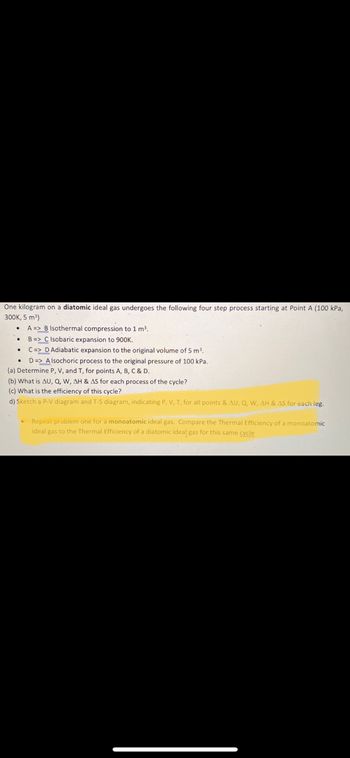
Elements Of Electromagnetics
7th Edition
ISBN: 9780190698614
Author: Sadiku, Matthew N. O.
Publisher: Oxford University Press
expand_more
expand_more
format_list_bulleted
Question
Answer the highlighted part

Transcribed Image Text:One kilogram of a diatomic ideal gas undergoes the following four-step process starting at Point A (100 kPa, 300K, 5 m³):
- **A -> B**: Isothermal compression to 1 m³.
- **B -> C**: Isobaric expansion to 900K.
- **C -> D**: Adiabatic expansion to the original volume of 5 m³.
- **D -> A**: Isochoric process to the original pressure of 100 kPa.
### Tasks:
(a) Determine P, V, and T for points A, B, C, and D.
(b) What is ΔU, Q, W, ΔH, and ΔS for each process of the cycle?
(c) What is the efficiency of this cycle?
(d) Sketch a P-V diagram and T-S diagram, indicating P, V, T for all points & ΔU, Q, W, ΔH, and ΔS for each leg.
(e) Repeat problem one for a monoatomic ideal gas. Compare the thermal efficiency of a monoatomic ideal gas to the thermal efficiency of a diatomic ideal gas for this same cycle.
Expert Solution
This question has been solved!
Explore an expertly crafted, step-by-step solution for a thorough understanding of key concepts.
Step by stepSolved in 4 steps with 19 images

Knowledge Booster
Learn more about
Need a deep-dive on the concept behind this application? Look no further. Learn more about this topic, mechanical-engineering and related others by exploring similar questions and additional content below.Similar questions
- How do you draw both triangles?arrow_forwardI need these three parts answered (Multiple Choice). If you can not answer all three parts please leave it for another tutor to answer. Thank you. For the two holes identified as datum D, what is the total size tolerance specified for those holes? (Multiple Choice)a. .002'b. .003'c. .004'd. .006' The two holes identified as datum D have a counterbore on one end. What size toleranceis specified for the counterbore diameter? (Multiple Choice)a. .010″ (±.005″; see title block)b. .020″ (±.010″; see title block)c. .030″ (±.015″; see title block) What letter represents the revision status of this print? (Multiple Choice)ABCDarrow_forwardi) The displacement at point A. Enter your answer in mm to 2 decimal places.arrow_forward
- you solved it with a total distance of 8, not 10 like the question said. please resolve with a distance of 10arrow_forwardQ6 Each cylinder of six cylinder internal combustion engine has a diameter of 60 mm and a stroke length of 400 mm. What is the engine capacity in litres? Give your answer to 2 decimal places.arrow_forward
arrow_back_ios
arrow_forward_ios
Recommended textbooks for you
 Elements Of ElectromagneticsMechanical EngineeringISBN:9780190698614Author:Sadiku, Matthew N. O.Publisher:Oxford University Press
Elements Of ElectromagneticsMechanical EngineeringISBN:9780190698614Author:Sadiku, Matthew N. O.Publisher:Oxford University Press Mechanics of Materials (10th Edition)Mechanical EngineeringISBN:9780134319650Author:Russell C. HibbelerPublisher:PEARSON
Mechanics of Materials (10th Edition)Mechanical EngineeringISBN:9780134319650Author:Russell C. HibbelerPublisher:PEARSON Thermodynamics: An Engineering ApproachMechanical EngineeringISBN:9781259822674Author:Yunus A. Cengel Dr., Michael A. BolesPublisher:McGraw-Hill Education
Thermodynamics: An Engineering ApproachMechanical EngineeringISBN:9781259822674Author:Yunus A. Cengel Dr., Michael A. BolesPublisher:McGraw-Hill Education Control Systems EngineeringMechanical EngineeringISBN:9781118170519Author:Norman S. NisePublisher:WILEY
Control Systems EngineeringMechanical EngineeringISBN:9781118170519Author:Norman S. NisePublisher:WILEY Mechanics of Materials (MindTap Course List)Mechanical EngineeringISBN:9781337093347Author:Barry J. Goodno, James M. GerePublisher:Cengage Learning
Mechanics of Materials (MindTap Course List)Mechanical EngineeringISBN:9781337093347Author:Barry J. Goodno, James M. GerePublisher:Cengage Learning Engineering Mechanics: StaticsMechanical EngineeringISBN:9781118807330Author:James L. Meriam, L. G. Kraige, J. N. BoltonPublisher:WILEY
Engineering Mechanics: StaticsMechanical EngineeringISBN:9781118807330Author:James L. Meriam, L. G. Kraige, J. N. BoltonPublisher:WILEY

Elements Of Electromagnetics
Mechanical Engineering
ISBN:9780190698614
Author:Sadiku, Matthew N. O.
Publisher:Oxford University Press

Mechanics of Materials (10th Edition)
Mechanical Engineering
ISBN:9780134319650
Author:Russell C. Hibbeler
Publisher:PEARSON

Thermodynamics: An Engineering Approach
Mechanical Engineering
ISBN:9781259822674
Author:Yunus A. Cengel Dr., Michael A. Boles
Publisher:McGraw-Hill Education

Control Systems Engineering
Mechanical Engineering
ISBN:9781118170519
Author:Norman S. Nise
Publisher:WILEY

Mechanics of Materials (MindTap Course List)
Mechanical Engineering
ISBN:9781337093347
Author:Barry J. Goodno, James M. Gere
Publisher:Cengage Learning

Engineering Mechanics: Statics
Mechanical Engineering
ISBN:9781118807330
Author:James L. Meriam, L. G. Kraige, J. N. Bolton
Publisher:WILEY